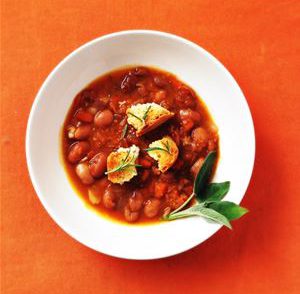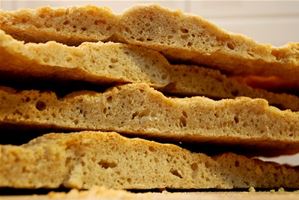Driving back from Puglia in August, on the stretch between Bari and Naples, I passed 36 trucks filled to their brims with pomodori San Marzano, on their way to the canneries. I dodged the tomatoes flying out of the overflowing open-top trucks as they wound their way up the pass to Avellino and then down towards Naples, the drivers moving fast to evade fines for hauling the overweight cargo.
Italy works in funny ways: dodging the flying tomatoes was my friendly reminder that it was time to make passata di pomodoro while the sun still shines.
Not only is the tomato one of the ingredients that unites of Italian cuisine in a country of vast regional variety, but passata di pomodoro is an important base all year round. It is like spaghetti, aglio, olio e pepperoncino-all the ingredients are simple, but the method and the quality of the ingredients are fundamental to its success.
The tomato. Florentines started eating tomatoes (pomo d’oro: the golden apple, as it was thought to begin as a small yellow fruit) after a couple of hundred years of using them as a decorative table centrepiece, so suspicious were they of these vegetable-fruits the Spaniards brought into Europe from Peru after the colonization of the Americas. Tomatoes were first incorporated into Tuscan recipes around the early eighteenth century. Now the tomato is the backbone of Tuscan regional cuisine, from pappa al pomodoro to schiacciata al pomodoro.
In the south of Italy, passata di pomodoro is based on whichever type of tomato grows best in the given region; whereas in central Italy and the north, cooks are more likely to choose their favourite tomato. I prefer to use pomodori San Marzano: it has a low acid content, and an amazing, intense flavour that really captures the sun-very important qualities when you are making passata di pomodoro in quantities to last the whole year. This tomato also makes preparation easier as it has low loose-water content, a thick flesh, small core and few seeds. If you can’t find pomodori San Marzano, the next best choices are roma tomatoes or vine-ripened round tomatoes.
To market! The process of making your passata di pomodoro starts at the market (or in your garden, if you have one). Choose the most fragrant and ripe tomatoes available. They need to be maturi, nice and ripe, but not bruised or soft to the touch. The skin should still be firm and the pomodori should be fragrant and a vibrant red. This is fundamental to your passata: if the tomato doesn’t smell good, the sauce is not going to hold the flavor.
Pick up the tomato, check the tightness of the skin, the colour, then, most important of all, smell the tomato at the spot where the green core was attached to the plant. If you smell that wonderful odor of the leaves, of a foglio di pomodoro, then the taste will be present in the tomato. You have the right fruit. Now buy as many boxes as you dare! If you arrive at the market towards the end of the day, you can even bargain a discount for boxes or buy tomatoes by the kilo so they don’t have to pack up the fruit again to sell the next day.
While you’re there, pick up some heads of garlic, a few bunches of basil, some rock salt and bottles or jars for bottling.
Method. Believe me when I say this: making passata di pomodoro takes half a day more than it takes to explain how to make it, so be sure you have not only good tomatoes, but also good company and at least half a day to devote to the process. The nonnas often start with their entire families at 4am to be finished by lunchtime.
Wash the whole tomatoes, discard any duds, cut the green end off (with San Marzano it is easy as you have little wastage and don’t have to fluff around with a knife to core them).
Cut each tomato in half lengthways, then squeeze gently over the sink to remove most of the seeds. Place the halved tomatoes in a heavy-based pan, add 3 percent salt to the weight of the tomatoes, whole cloves of garlic and basil leaves to taste. Without adding water, cover the pan and place on the heat until the tomatoes are releasing their water and boiling. Mix slowly with a wooden spoon until they are cooked to a soft pulp.
Shut off the heat and pass the tomatoes through ‘il passaverdura’ (vegetable sieve or food mill, sometimes known by the brand name ‘Mouli’). As you turn the mill, the cooked tomatoes emerge as a fleshy pulp. Any remaining skin and seeds can be discarded. Put the puree back into the pot and bring it to the boil, then let it simmer for about 3 minutes. If you have used the right tomatoes, the passata should already be slightly dense and ready for bottling.
Have ready heated, sterilized bottles or jars, and fill them with the passata, leaving a little space at the top. Put the lids on tight and leave to cool slowly. Wash the outside of the bottles once the passata is cool. Store in a cool dark place. The idea is to make enough to last all year, so even when the fresh tomatoes are not in season, you still have them in your jars. You have bottled their essence, which, I truly believe, is the Italian sunshine. You taste it in fresh tomatoes right now, and you can taste it the passata if you make it at the right time of year-now, while the sun still shines.
While you’re at it, take a break for lunch. Toast some bread over the naked flame on the stove, add a sprinkling of salt and some extra virgin olive oil, then steal some fresh warm passata out of the pot. Taste the sunshine, and you will be surprised at how good it is and how long you will remember this simple meal!
Buon apettito!







